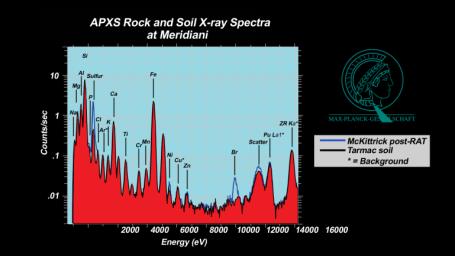
|
Salty Martian Rock
- Click the image above for a larger view
- Full-Res JPEG (1920 x 1080) (161.6 kB)
- Full-Res TIFF (1920 x 1080) (597.0 kB)
Caption:
These plots, or spectra, show that a rock dubbed "McKittrick" near the Mars Exploration Rover Opportunity's landing site at Meridiani Planum, Mars, has higher concentrations of sulfur and bromine than a nearby patch of soil nicknamed "Tarmac." These data were taken by Opportunity's alpha particle X-ray spectrometer, which produces a spectrum, or fingerprint, of chemicals in martian rocks and soil. The instrument contains a radioisotope, curium-244, that bombards a designated area with alpha particles and X-rays, causing a cascade of reflective fluorescent X-rays. The energies of these fluorescent X-rays are unique to each atom in the periodic table, allowing scientists to determine a target's chemical composition.
Both "Tarmac" and "McKittrick" are located within the small crater where Opportunity landed. The full spectra are expressed as X-ray intensity (logarithmic scale) versus energy. When comparing two spectra, the relative intensities at a given energy are proportional to the elemental concentrations, however these proportionality factors can be complex. To be precise, scientists extensively calibrate the instrument using well-analyzed geochemical standards.
Both the alpha particle X-ray spectrometer and the rock abrasion tool are located on the rover's instrument deployment device, or arm.
Cataloging Keywords:
| Name | Value | Additional Values |
|---|---|---|
| Target | Mars | |
| System | ||
| Target Type | Planet | |
| Mission | Mars Exploration Rover (MER) | Mars Science Laboratory (MSL) |
| Instrument Host | Opportunity (MER-B) | Curiosity Rover |
| Host Type | Rover | |
| Instrument | Alpha Particle X-Ray Spectrometer (APXS) | Rock Abrasion Tool (RAT) |
| Detector | ||
| Extra Keywords | Color, Crater | |
| Acquisition Date | ||
| Release Date | 2004-03-02 | |
| Date in Caption | ||
| Image Credit | NASA/JPL/Cornell/Max Planck Institute | |
| Source | photojournal.jpl.nasa.gov/catalog/PIA05469 | |
| Identifier | PIA05469 | |
